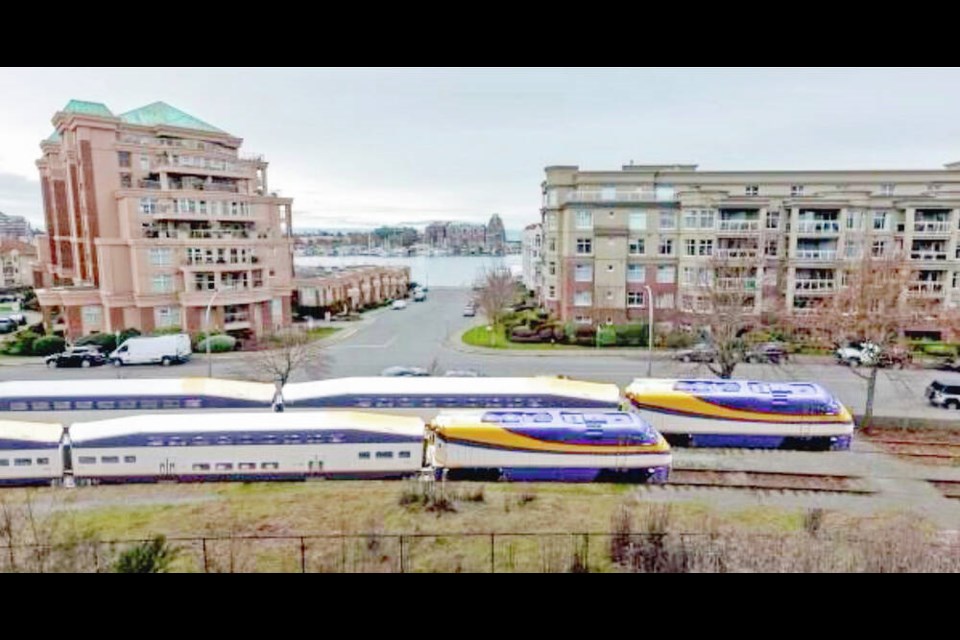The Island Corridor Foundation is seeking support from senior governments for a $431-million rail system that runs a passenger service between Courtenay and Victoria and carries freight.
Under the foundation’s newly released business plan, construction costs would be $381 million, with another $50 million needed to buy rolling stock. Money to set up the service and upgrade rail-corridor infrastructure would come from provincial and federal governments if they agree to support the plan.
The business case’s most conservative estimate for operating costs would put the service in a break-even position at the start, with anticipated revenues and costs bringing in operating profits.
It would be sustainable in the long term, said Larry Stevenson, chief executive of the non-profit foundation, which owns the corridor.
Annual operating costs would be $12.8 million, with revenue scenarios running from $12.7 million up to $23.4 million.
The aim is not to bring back the Via Rail Dayliner service, which last operated in 2011 between Victoria and Courtenay before shutting down over concerns about deteriorating tracks, but to introduce a “modern, efficient, reliable rail system,” Stevenson said Wednesday.
Commuter service is “very much needed,” Stevenson said. “I think we all know that.”
Options for getting traffic off the road between the West Shore and downtown have long been debated in the region.
Some residents are keen to see a B.C. Ferries link between Colwood and Victoria, but the province earlier put the brakes on that idea and it is not being pursed by B.C. Ferries, president Mark Collins said recently.
The modern rail system envisioned by the foundation would see inter-city regional trains running out of Duncan and Courtenay, plus freight service to Port Alberni, with its deep-water port, and Nanaimo. Stevenson said Port Alberni could be a destination for vessels to deliver goods to the Island and beyond.
The business case envisions tourist trains that would run as demand dictated, said Stevenson, who predicts they would be profitable.
While heavy rains in November caused damage that resulted in temporary closure of part of the Malahat, significantly disrupting a major Island supply route, the rail corridor was relatively unscathed, Stevenson said. A small area was washed out and was restored in four hours, he said.
A third-party operator would run the system, not the corridor foundation, which is recommending establishing a working group with governments to work on plans to bring rail service back to the Island.
Initial exchanges of information have already taken place with the province over the foundation’s plan, Stevenson said.
A key factor in reviving rail service would be resolving outstanding issues with First Nations around the original land grants set up to establish rail on the Island.
Judith Sayers, co-chair of the foundation and president of the Nuu-Chah-Nulth Tribal Council, said resolution of those issues is critical, calling on the provincial and federal governments to work with Island First Nations to settle them.
In mid-September 2021, the Snaw-Naw-As First Nation lost a court appeal to regain a portion of E&N Railway land. The First Nation had argued that because land now designated as a railway right-of-way cuts through the reserve, it blocks potential development, leading to economic losses.
The B.C. Court of Appeal gave the federal government 18 months — until March 2023 — to decide if it wants to see the line restored and if it will contribute funds.
Islanders have been split on whether to bring passenger rail service back in the wake of the 2011 closure, with some arguing that it’s a way to link communities economically and foster greener transportation as the Island’s population grows, while others say it would be a waste of taxpayers’ money.
Friends of Rails to Trails Vancouver Island has advocated for a multi-use trail on the rail line for walkers, runners and cyclists.
A 2020 report by a consultant for the province set out a range of scenarios for restoring rail service on the Island. The priciest option would have cost $729 million for Victoria to Courtenay, with a leg to Port Alberni. Adding Langford-Victoria commuter rail would increase the cost by another $595 million.
That proposal did not proceed.
The Ministry of Transportation did not immediately respond to a request for comment on the foundation’s plan.



